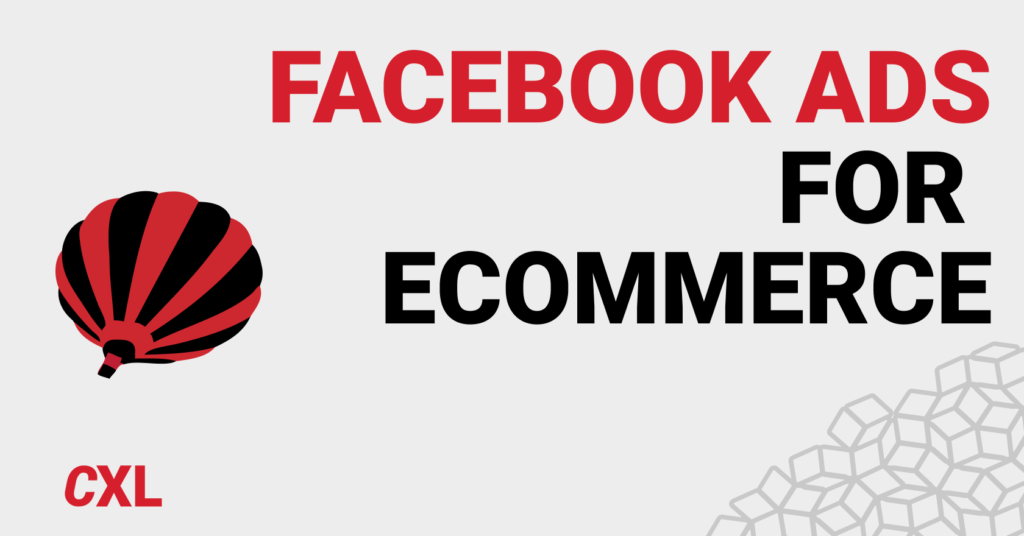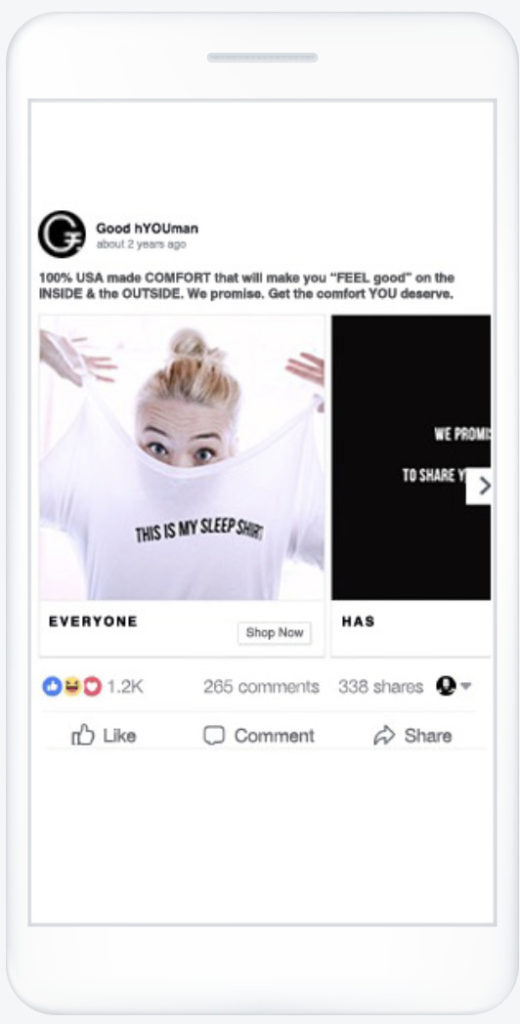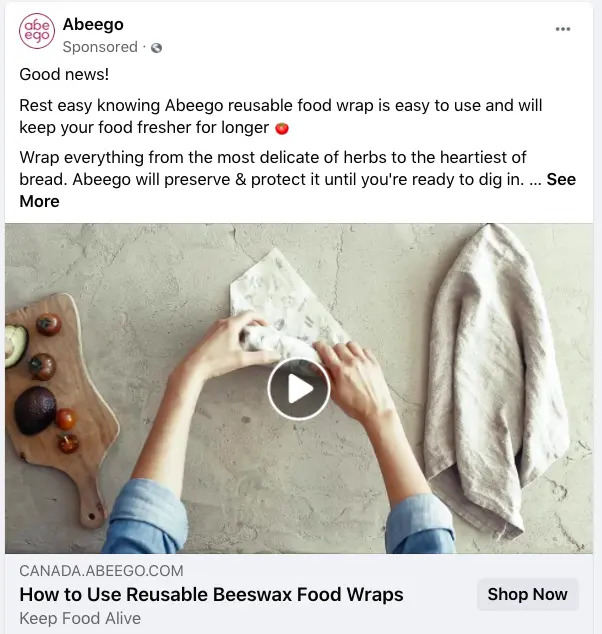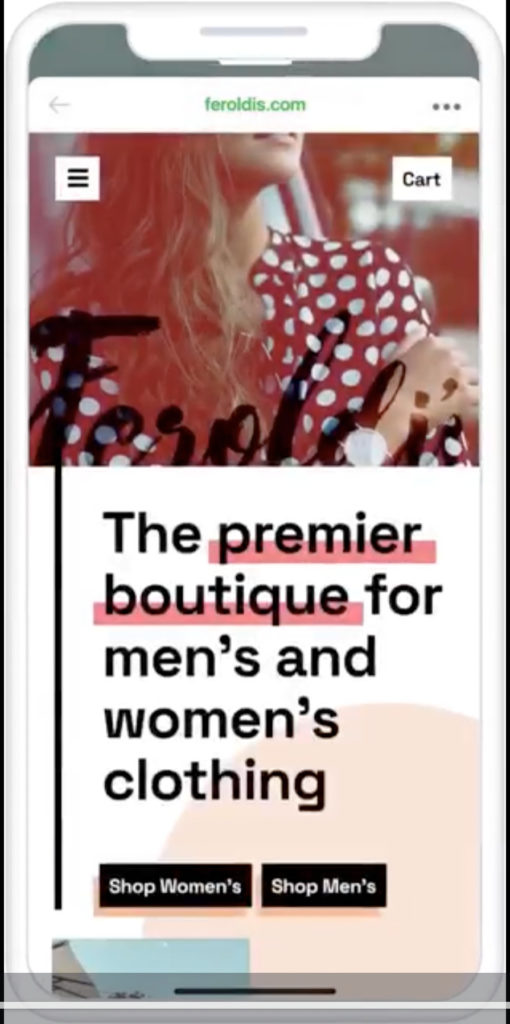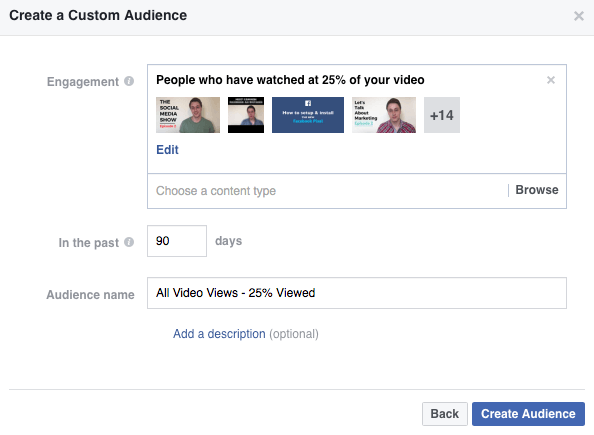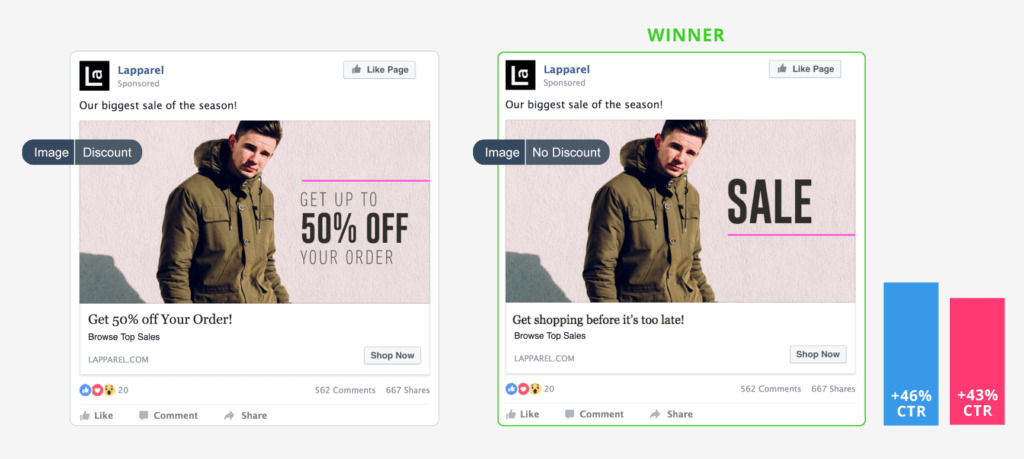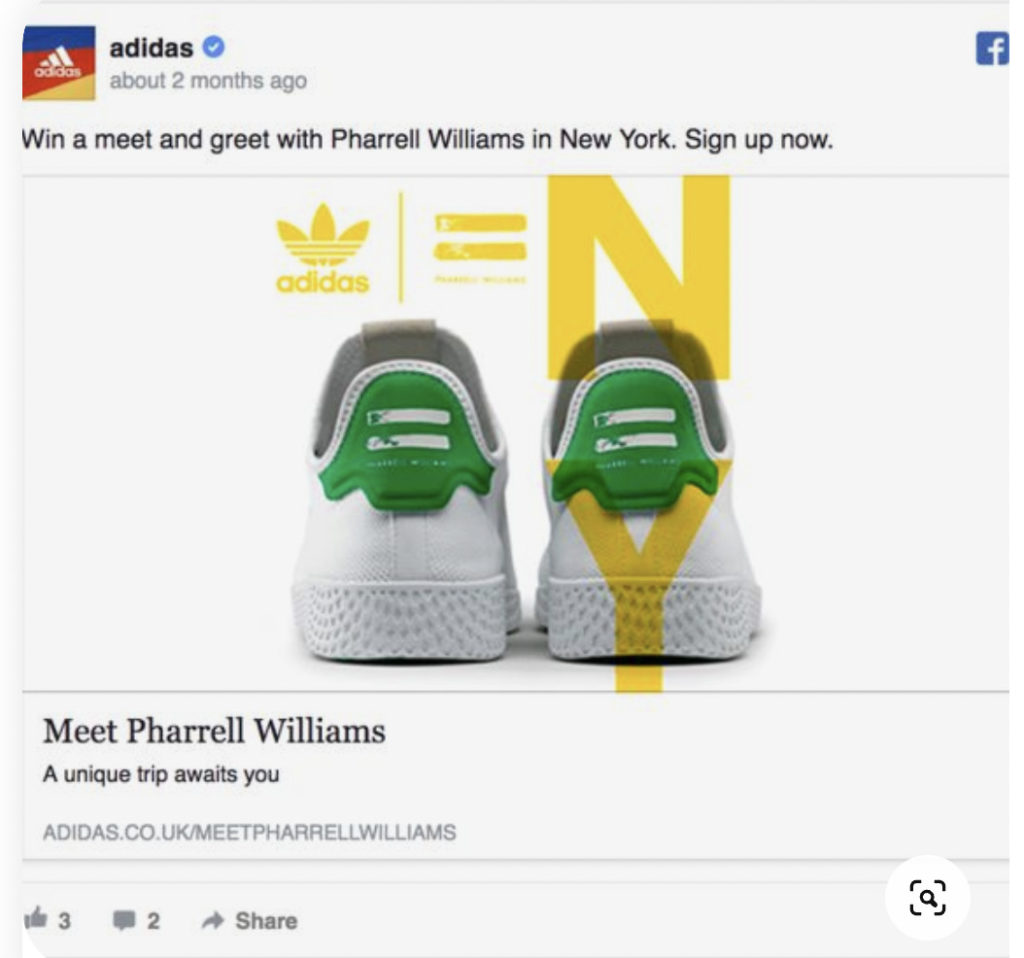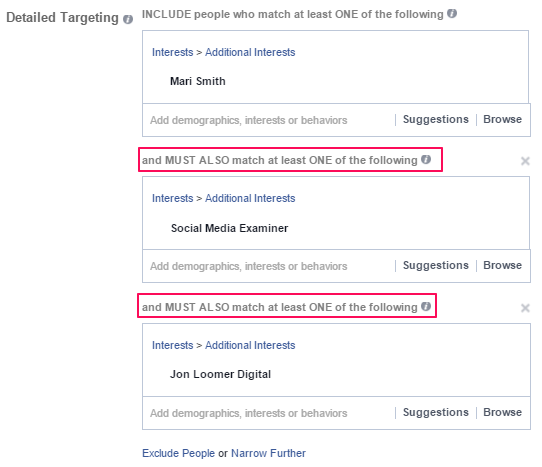According to Insider Intelligence, online retail sales will reach $7.4 trillion by 2025, making up around one quarter of all retail sales.
With ad costs rising on Facebook (and across platforms), ecommerce marketers who want a slice of this pie will need to up their Facebook ad game to stand out and remain in play.
In this article, you’ll learn how to use customer insights and competitive analysis to develop a powerful Facebook ad strategy for your ecommerce that engages, converts, and drives revenue growth.
Table of contents
- Base your ecommerce Facebook ads strategy on deep customer research to resonate
- Use voice of customer research to uncover key motivators
- Find your differentiator through competitive analysis
- Segment your existing customers to find your best audience
- Choose your player: Nail down your type of ad to capture user attention
- Let your digital marketing goals inform Facebook ad objectives
- 5 tactics for running effective ecommerce ads on Facebook
- 1. Leverage Lookalike audiences to reach new customers
- 2. Build your first iterations based on customer research (and be prepared to throw it out the window)
- 3. Personalize your retargeting ads and time them right to make the biggest impact
- 4. Find the best mix between sales and brand-focused ads
- 5. Win competitor’s customers with intent-based targeting
- Conclusion
Base your ecommerce Facebook ads strategy on deep customer research to resonate
Scroll through your Facebook feed right now and you’ll come across dozens of ads. How many captured your attention?
The bar is low for setting up Facebook ads; it’s easy for any business to run an ad. Designing an effective ad that resonates with your audience and achieves your marketing goals is more challenging.
Many ecommerce marketers fail to invest sufficiently in the biggest key to effective ads: customer research.
Neglecting customer segmentation means neglecting to understand what truly captivates and motivates your audience. When this happens, messaging falls flat.
To design ecommerce Facebook ads that capture attention and earn click-throughs, learn your customer’s intentions, motivations, and desires.
Use voice of customer research to uncover key motivators
Go beyond basic characteristics in shallow persona exercises to determine what drives a customer to purchase from your brand over your competitors.
In a 2013 Edelman survey of 11,000 people, a majority of respondents reported concern that businesses don’t ask about their needs often enough. Only 10% of respondents felt businesses were doing a good job of it.
This trend is holding strong. A 2019 Microsoft survey found similar results, with 89% of respondents saying they want to give feedback to companies.
Marketers can get caught up in creating buyer personas that they think represent their best customers, then scratch their heads when they don’t get results.
Moz’s Rand Fishkin expressed frustration around this while building his new site SparkToro:
“Build personas → Make sure they get used across the company → Create product and marketing initiatives to employ the personas → Get no benefit at all → Doh!”
Instead of creating top-down personas, work bottom-up and build buyer personas with data.
Voice of customer (VOC) research helps you determine customer wants and needs on a qualitative basis and in their own words.
It’s a process of asking qualitative questions and categorizing answers based on customer challenges and product features. Use verbatim phrases to address those challenges in your messaging.
Ask open-ended questions like:
- When did you realize you needed a product like ours?
- What alternatives did you consider prior to purchasing from us?
- How does our product impact your life right now?
- What concerns or objections did you have before deciding to purchase from us?
Extract the language your customers use on a day-to-day basis and apply these to your ads to instantly relate.
For instance, you might find that customers are particularly drawn to your “easy checkout process.” Leverage this in your ad copy: “Get shipped in under a minute with our easy checkout process.”
Find your differentiator through competitive analysis
In the previous step, your goal was not just to find what motivates customers to buy, but what motivates them to buy from you.
Dig deeper into your brand’s differentiating points through two components of competitive analysis:
- Areas where you overlap with competitors (in terms of features and value propositions);
- Areas where you and your competitors differ.
Take Buck Mason, an online clothing ecommerce business.
Their line of men’s casual shirts looks similar to what’s on offer by other men’s shirts retailers.
Though there is overlap in pricing and style, their brand stands out with longevity.
Buck Mason shirts are built to last, meaning buyers don’t need to repurchase regularly and contribute less to fashion waste. With Millennials and Gen Z increasingly reporting preferences for sustainable consumer options, durability is an appealing benefit for this audience.
Buck Mason leverages this differentiating point in their Facebook ad copy:
- “Strong fabrics”;
- “Last (practically) forever”;
- “Time-tested shirts.”
Find your most competitive angle and position your product using language from your voice of customer research.
Segment your existing customers to find your best audience
Some businesses with a very niche product may have a single audience to target. Others will have multiple audiences with varying motivations for purchasing.
Say you’re a grammar and spell-checking SaaS company. Your target market may include students, businesses that need help sending professional documents and emails, and freelance copywriters.
But there’s more depth to your customers’ motivations than their job roles.
If you’re running a freemium model, you’ll also be trying to upsell your free-plan users to a paid plan and potentially cross-sell all customers with any add-on products.
Your market groups have different needs, budgets, and motivations, all of which may shift depending on where they are in your sales funnel.
Generic ads that don’t speak to unique pain points and benefits will have a hard time landing with any group, so you’ll need to craft a separate ad for each.
Luckily, Facebook allows for detailed segmentation, helping you reach audiences while optimizing your campaign budget.
Tom Bukevicius, Principal at SCUBE marketing, recommends starting with your current customer base:
“Segmenting is so basic, yet you would be surprised at how few ‘marketers’ really make the most of it.…
So, how do you create these segments? Easy—your customer database. Even if it’s not complex, your customer database is a goldmine of useful, actionable data. I’m willing to bet you have access to the following data points:
– Purchase date;
– Purchase frequency;
– Purchase value;
– Product type;
– Newsletter subscribers.
Use these data points to construct customer segments, and then use them as Custom Audiences.”
Tom recommends using your existing data to group your ad audience into seven categories:
- Potential customers;
- One-time buyers;
- Repeat customers;
- Lapsed customers;
- First-time buyers;
- Recent buyers;
- High-value buyers.
From there, you can create Lookalike audiences and dive into demographic indicators that resemble your target audience (we’ll cover those later).
Segment your audience not just by basic information, such as job roles, but by location on the buying journey. This will help you uncover their true motivations.
For example, check out vidIQ’s ad:

This is the ad users see when they downgrade from a paid plan to the free plan. It doesn’t ask users to sign up for a free trial (because they’ve already tested the platform).
The copy taps into what motivated users to sign up in the first place: grow on YouTube and earn an income.
In this ad, the brand targets a budding YouTuber with financial goals. They’re not a potential customer or a first-time buyer; they’re a lapsed buyer that vidIQ is trying to claim back by reminding them why they got started.
Segment your audience to reach them with the most effective messaging.
Choose your player: Nail down your type of ad to capture user attention
Once you’ve grouped your audience you’ll want to figure out how to reach them. Are stills best for your audience or will they stick around to watch a video?
There are several formats for ecommerce Facebook ads, including:
- Image;
- Video (e.g., standard video, poll, stories, etc.);
- Carousel;
- Instant experience (full-screen dynamic product ads that open on a mobile device);
- Collection (multiple Instant Experiences that users can tap on in a gallery).
The first three in the list are the most popular in ecommerce.
Image ads
Image ads are the quickest to produce as you’re only designing a single crisp still creative. Your ad copy will be crucial to engage users and encourage them to click.
In a single sentence, underwear company Stance make it explicitly clear who their audience is (“the fashion curator with street appeal”) and the benefits they’ll get by wearing their socks (sophistication).
For image ads, high-quality, high-resolution images are key. Avoid busy compilations and keep to a single focal point with a clear and direct message.
Carousels
Carousel ads, multiple images that users can swipe through, are ideal for showcasing multiple items in your product catalog at once. They can be individual images (like the example below) or one continuous image (as seen in the Buck Mason example above).
Because users must swipe through to see all images, they’re more actively engaged than when viewing a single image.
You can even mix it up, alternating between product images and brand quotes to boost awareness of your brand’s values.
Video
When you think of video on social media, other platforms may come to mind first (e.g., TikTok and YouTube). Video is quickly growing on Facebook, now making up half the time users spend on the platform.
There are six types of Facebook video ads:
- Short Videos and GIFs
- Vertical Videos
- Stories
- Video Carousels
- Video Collections
- In-stream Videos
Videos are effective for demonstrating your product in action, particularly if the intended use is not so obvious at a glance.
Take Abeego, an online store for reusable beeswax food wrap.
Unless you’re already familiar with beeswax wraps, it may not be instantly clear how to use this product from a still image.

Abeego’s video Facebook ad serves two purposes: capturing attention by showing the product in its environment and educating new audiences on how to use it.
The format you choose will depend on your audience (i.e. do they prefer video content) and your budget. Video is more involved, often requiring storyboarding and a production team.
However, there is an increasing amount of software solutions to quickly create budget-friendly Facebook video ads, like Biteable and Animoto.
Let your digital marketing goals inform Facebook ad objectives
Your ecommerce marketing goals should inform the direction your ads take and the objectives you choose in the Facebook Ads Manager.
Before digging into creative development, copywriting, or ad set deployment, prioritize and rank your goals according to your wider marketing strategy.
Do you want to:
- Gain maximum reach to influence brand awareness?
- Drive traffic to your website?
- Connect with customers via Facebook Messenger?
- Capture leads for your sales and marketing teams to nurture?
- Generate sales directly from the ad?
Your marketing goals dictate the rest of your ad elements, like which format to use and where your ads should appear.
A brand awareness Facebook ad campaign may look like a still image on the homepage, acting as a placeholder in Facebook users’ minds until they’re ready to buy.
An ad attempting to generate sales directly may look like a video demo or a more interactive Instant Experience ad:
The Ads Manager platform in your ad account will ask you to specify your goal, so have these figured out before you get started.
Nail down your marketing goals for each campaign so the algorithm can push your Facebook advertising toward the right objectives.
5 tactics for running effective ecommerce ads on Facebook
Running ads on Facebook is not a passive activity. For the best results (and most optimized ad spend), you’ll need to be constantly testing and monitoring.
You’re at least part of the way toward an ideal ad with the research above. Next you can begin building your ad audience in Facebook’s Ad Manager.
1. Leverage Lookalike audiences to reach new customers
Your current customers provide a wealth of information on the types of people who buy your products. If your goal is to acquire new customers, start with the people already on your books.
Once you’ve segmented them according to where they are in the buyer journey, you can build Lookalike audiences.
Say your marketing goal is to drive traffic to your blog. You can use an existing source audience (e.g., your customer list or people who engaged with a recent video campaign) to point the algorithm toward people with similar characteristics.
You can also build a Lookalike audience from recent visitors to your blog using the Facebook Pixel on your blog page.
Once you’ve created your audience, you can tell Facebook how closely you want your audience to match your source audience.
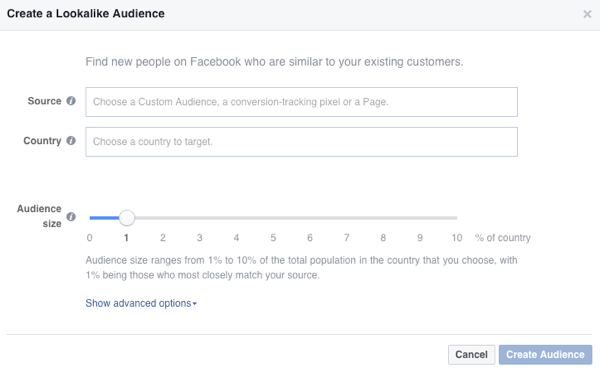
Social Media Examiner recommends starting at the lower end (1%) and increasing as you scale your campaign.
Leverage Lookalike audiences to target people with similar interests to those who already buy your products.
2. Build your first iterations based on customer research (and be prepared to throw it out the window)
Understand early on that your first ad creative and copy is not likely to be the best option. Test several options and keep optimizing to maxmize your budget and reach.
Take this example from clothing ecommerce brand Lapparel.
The agency that ran this ad tested the two offers to see which would work. It’s easy to assume the ad with a specific discount would generate more click-throughs, but in this case, curiosity won: the Facebook ad without a specific discount mentioned generated around 45% more clicks.
In another example, the agency tested images with and without copy. With the specified audience, images without copy generated 40% more clicks from women and 54% more clicks from men.
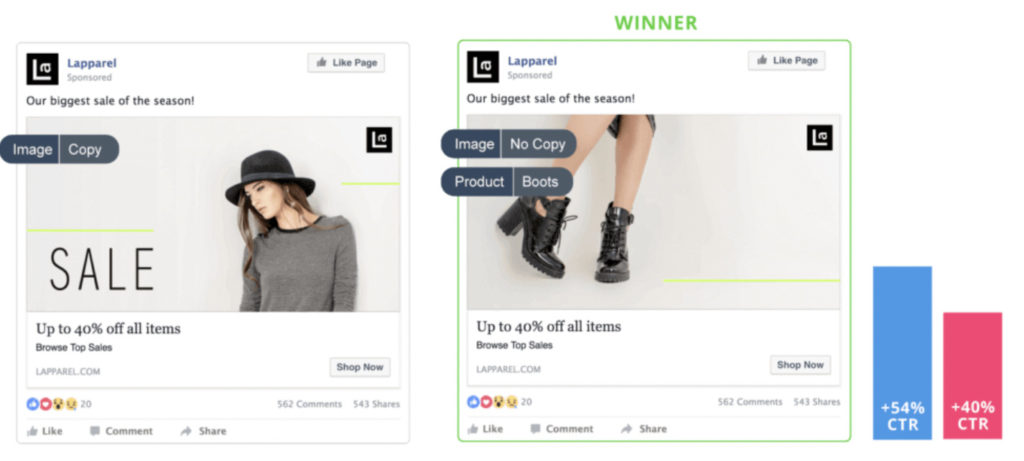
Draft your first ad versions to test and keep an open mind about revising ads until you’ve got a winning formula. (Then keep testing.)
3. Personalize your retargeting ads and time them right to make the biggest impact
Retargeting (aka remarketing) ads are great at capturing repeat and almost-customers. Using the Facebook Pixel, you can target cart abandonment and capitalize on impulse purchases, or update past customers about new products they’d love.
Retargeting is more than flashing up images of previously viewed products. Doing so may scoop up customers who got distracted during checkout, but won’t entice customers who clicked away due to other obstacles, such as price.
To make the biggest impact on missed opportunities, understand what drives customers away, and then upgrade and personalize your offer.
Take a recent experience I had with Adidas. I browsed this style of shoe on their website several months back.
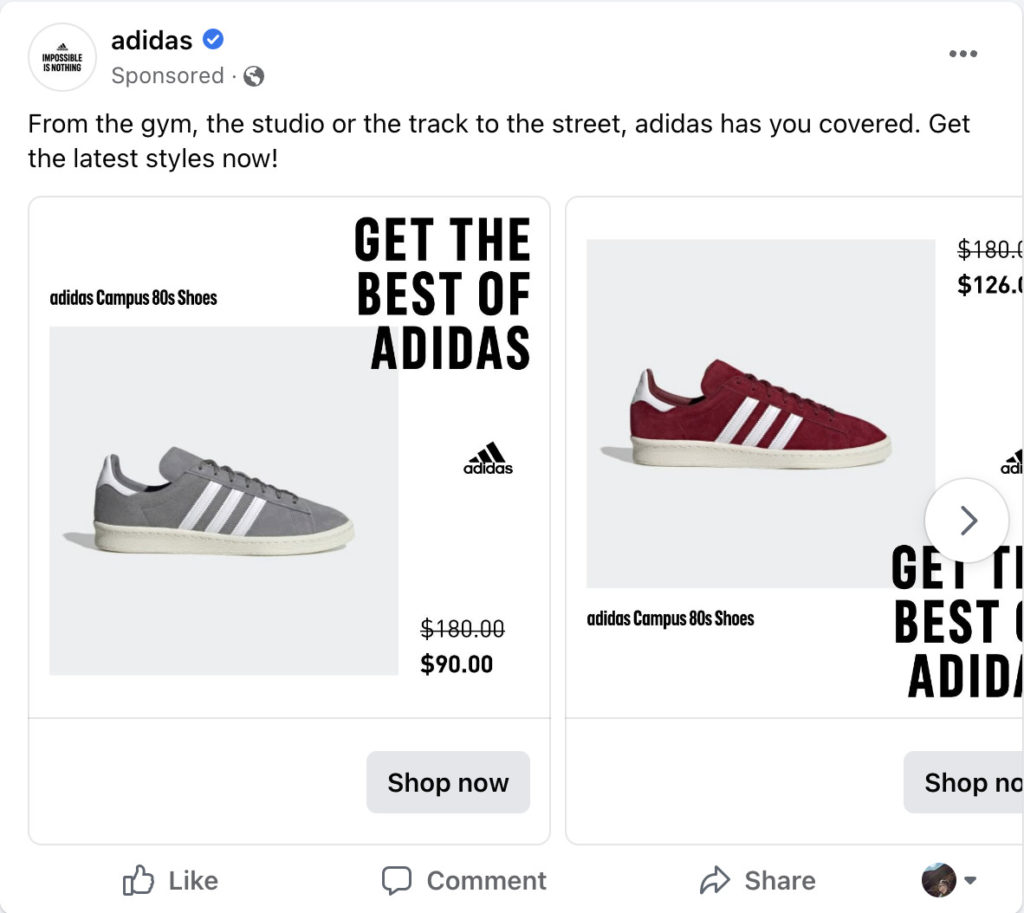
A few weeks ago, I started seeing retargeting ads for three colors—now discounted from $180 to $126. Adidas pushed their sale items toward people who have shown interest in the product on their website.
I didn’t purchase any of the three shoes, but I did click on the ad CTA for the grey option. The ads I now see are personalized with the grey option exclusively (and an additional discount).
If you’re running a sale, consider retargeting users who showed an interest in your sale items. Retarget your ads with exclusive offers at the right time for the best chance of winning conversions.
4. Find the best mix between sales and brand-focused ads
Brands that fail to communicate with buyers beyond “buy our thing” come across as aggressive and pushy.
Today’s buyers want to know what you can do for them. They want to buy from brands that personalize the conversation, invest in sustainability and longevity, and are part of the wider social conversation.
For example, Adidas sends through promotional ads (as seen above), but they also engage with buyers outside of straightforward selling.
In this ad, Adidas builds brand equity by working with influencers:
HubSpot is a CRM platform. But the brand also runs ads to its blog content and webinars to offer value and establish authority:
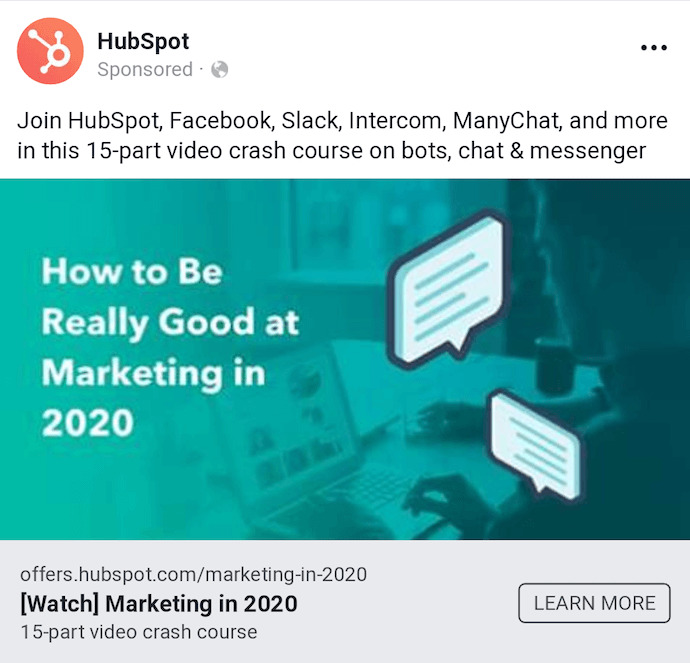
Add brand-focused media to your ad campaign strategy to inspire loyalty and nurture customer relationships.
5. Win competitor’s customers with intent-based targeting
Brand loyalty is changing. While die-hard fans still exist, the abundance of options offered by ecommerce shopping makes buyers more fickle, and the number of brands each customer is “loyal” to is growing.
Use Detailed Targeting options to get in front of your competitor’s customers via your competitor’s Facebook page.
For the best results, niche your ad toward specific products.
There would be little point in Adidas targeting customers of Converse with an ad for running shoes. This Adidas model is similar to the Chuck Taylor high top and could meet a Converse buyer’s intent when it comes to new shoes:
An Adidas ad targeting Converse customers would then want to point out how their high tops are better.
Identify where your products overlap with competitors, build an audience of competitor customers, and leverage the difference between your two products in your ad messaging.
Conclusion
The best Facebook campaigns are rooted in a deep understanding of customer intentions, challenges, and desires. This starts with customer research.
Divide your audience segments, find your angle, and keep your marketing goals front of mind as you build and iterate.
Learn how to boost Facebook business and drive more leads into your sales funnel with our Ecommerce Marketing Certification Minidegree.
